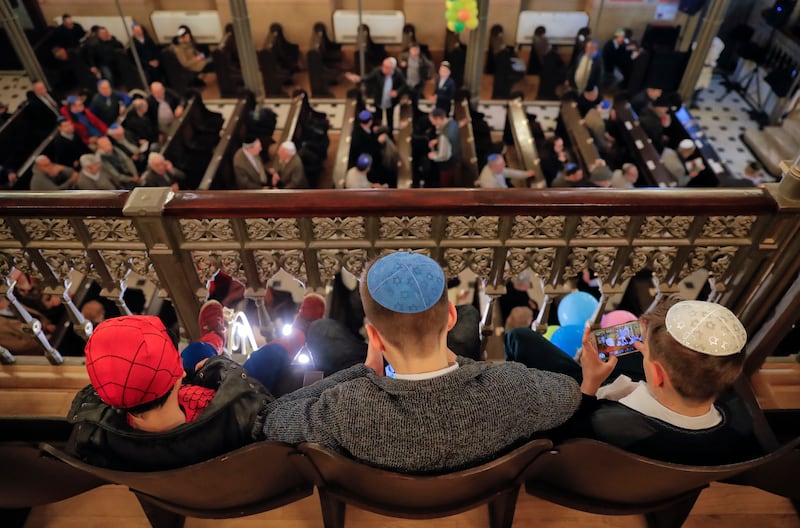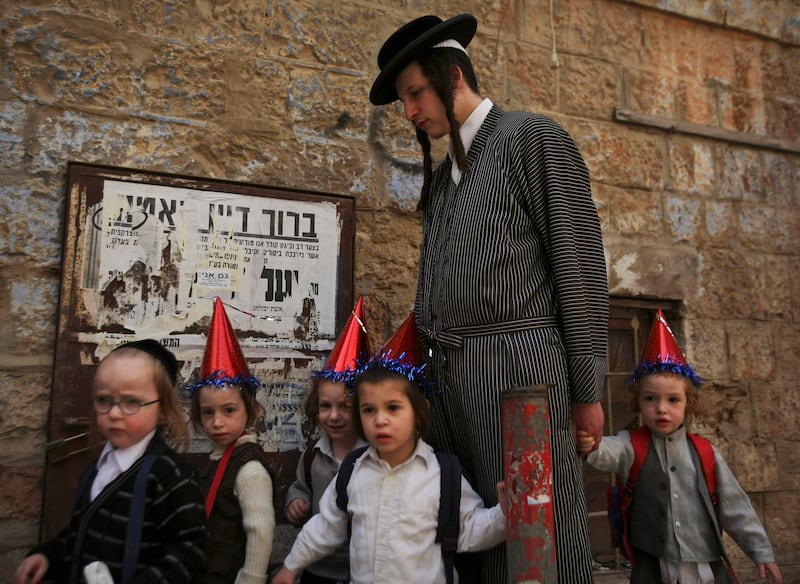Jews often joke that the stories behind most of our holidays can be summed up as, “They tried to kill us, they failed, let’s eat.” While the Jewish holiday of Purim — which, in the United States this year, begins on Wednesday at sundown and concludes on Thursday night — is in the same vein, it is distinguished from the others by being, hands down, our most joyful celebration. Purim is downright rowdy.
For the holiday, Jews dress up in costumes and make noise during the reading of the megillah, the scroll that contains the Book of Esther. The Talmud tells us to drink wine until we can’t tell an enemy from a friend.
In addition to partying, Purim is about generosity. As part of our observance of the holiday, Jews send sweet treats to friends and family and also give to the poor.
The story
The word Purim translates to “lots.” That matters because the holiday commemorates a scheme to kill the Jews of ancient Persia; as the story goes, the bad guys picked the day to attack at random by throwing lots.
The slightly longer version of the story behind the holiday goes like this: King Ahasuerus (Xerxes) wanted his wife, Queen Vashti, to display her beauty at a feast he was hosting for men. She refused. After Vashti was banished or killed (there’s a debate about her fate) for her disobedience, King Ahasuerus held a pageant for a new queen. Not knowing she was Jewish, he chose Esther.
Esther, who was also known by her Hebrew name, Hadassah, was an orphan raised by her cousin, Mordechai, who cared for her like his own daughter after her parents died. Mordechai told Esther to keep her nationality secret.
After Esther’s marriage to King Ahasuerus, Mordechai saved the king’s life by telling Esther about a plot he’d overheard to kill the king; Esther then told the king of the plot (crediting Mordechai, of course), and he was able to kill the two guards who were planning to assassinate him before they could attack.
But then Mordechai endangered his own life by refusing to bow to Haman, the king’s prime minister, explaining that he refused to do so because he is a Jew. Haman, enraged by Mordechai’s disobedience, ordered all the Jews of the kingdom to be killed.
The date of the planned attack on Jews — the 13th day of the Hebrew month of Adar — was chosen randomly, by the throwing of lots. But Esther saved the Jews by revealing her identity to King Ahasuerus who promptly had Haman killed instead.
The message
Beyond the obvious plot line of deliverance, there’s an encouraging message found within the story of Purim that extends beyond the holiday: it’s a reminder that one’s fortune can be down one day and up the next. It’s a reminder not to despair and to keep the faith. And it’s a reminder that our sorrow can turn to joy, mourning to celebration.
But Purim isn’t about being passive and blindly turning over one’s trust to God without attempting to intervene in events. No, Esther is an active agent of change. This fact points to the holiday’s other themes of bravery and courage — of standing up for what one believes in, as Esther did. This message resonates with the Jewish value of social justice.
Additionally, Esther’s two names — Hadassah and Esther, the latter sharing a root with the Hebrew word meaning “to hide” — connects Purim to the themes of hidden identities and revealing ourselves.
The celebration
There are four must-dos for the holiday: Jews are supposed to hear the Book of Esther, feast, donate to the poor and send treats to people who are not in our immediate family, including extended family members, friends and acquaintances.
At synagogues, observing Purim is far from a staid occasion. During the reading of the Book of Esther, costumed children and adults alike boo, stomp their feet and use groggers or ra’ashanim (noisemakers) to blot out Haman’s name. It’s a fun, noisy event.

Ahead of the holiday, there are often Purim carnivals and puppet shows for children explaining the somewhat complicated story of Esther. There are lots of cute children’s Purim songs (including my personal favorite “Leitzan Katan,” Little Clown — a simple ditty my kids can sing by heart as I’ve tortured their ears with it for years now).
While most children tend to pick pretty innocuous costumes for the holiday — every little girl wants to be Queen Esther! — both kids’ and adults’ choices have, on occasion, stirred some controversy. A group of Jewish organizations this year put out a statement, asking Jews to be culturally sensitive and not wear blackface or other potentially offensive costumes, as reported by the Jewish Telegraphic Agency.
In America, Purim is somewhat overlooked by secular Jews and it’s easy to feel like Purim is geared around children. But, in Israel, even adults get into the spirit of the day. In Tel Aviv, there are massive street parties where grown-ups celebrate the Jews’ victory over evil Haman.
The food!
Purim observance includes a feast during which many Jews eat kreplach, a dumpling filled with meat, cheese or sometimes potato. Kreplach is symbolic food that dovetails with the themes of Purim: just as the filling is hidden in the dough, as Esther’s identity was hidden, so is God’s presence or will sometimes not readily apparent to the eye.
For Purim, we also eat triangle-shaped cookies that are usually filled with poppyseeds, apricot or raspberry jelly, or chocolate (in recent years, it’s become increasingly common to find upscale, gourmet versions of these cookies, offering all kinds of different fillings). Most American Jews call these cookies by the Yiddish word hamantaschen; in Israel, they are called “oznei Haman,” Hebrew for Haman’s ears. The origin of the cookie and what it symbolizes — is it Haman’s ear or his hat or something else entirely? — is a topic of debate.


